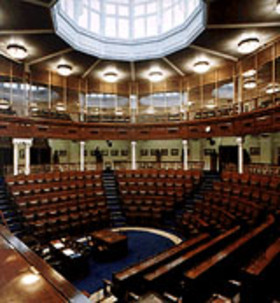Ireland

- Irish Parliament in Dublin (Photo: Irish Government)
Ireland has a population of 4.47 million and an area of 70,000 km2. It joined the EU in 1973 together with the UK and Denmark.
On 12 June 2008 Ireland had first voted "Níl" - No - to the Lisbon Treaty. The turnout was 53% of voters and there was a 54% No vote and a 47% Yes vote. France and Germany issued a joint declaration where they asked the remaining member states to ratify the Treaty. The Irish Government also agreed that the ratification process could continue in spite of the result.
In December 2008 the European Council decided that the Lisbon Treaty should enter into force on 1 January 2010. Ireland was therefore asked to change its No vote to the Lisbon Treaty. The Irish Government held a new referendum on 2 October 2009 following the adoption of the so-called Irish declaration at the European summit in June 2009. This time the Lisbon Treaty was ratified on a turnout of 58% of Irish voters, with 67% voting Yes and 33% voting No.
Ireland also delayed the coming into force of the Single European Act and the internal market by six months because of a legal challenge to how constitutional its mode of ratification was, in the Crotty case in of 1987.
Irish citizens voted "No" first time in a popular referendum on the Treaty of Nice on 7 June 2001 and thereby blocked the ratification process - all new EU Treaties must be ratified in all member countries to come into force. Ireland was the only EU/EC country to permit the Treaty of Nice to be put to a popular vote.
On this occasion the The Irish Government secured a declaration confirmning continued Irish neutrality. It introduced a system of parliamentary oversight of EU laws and organised a special forum for discussing Irish EU policy. Against this background a second referendum on 2 October 2002 was held under different referendum rules and with a different referendum question. In this second referendum 63% of the votes cast were now in favour of ratifying the Nice Treaty, on a turnout of 49.5% of Irish voters. One factor that may have influenbced this result was that another "No" was presented as a rejection of possible EU enlargement.
THREE FAMOUS COURT CASES
In 1987 an Irish farmer and economist, Raymond Crotty, won a court case safeguarding for Irish voters their right to have a constitutional referendum on the Single European Act of that year.In this case the Irish Supreme Court laid down that any surrender of nsovereignty to the EU must be approved by the Irihs people themseleves as they were the holders of sovereignty under the Irish Constitution.
In 1995 an Irish MEP, Patricia McKenna, won another court case preventing Irish Governments from using public money to attempt to obtain a particular resiult in a referendum. Public funds,if used at all, should be used in a neutral fashion as between the Yes and No sides. This principle was reaffirmed in a later Irish court case in 2012, taken by Mr Mark McCrystal.
In 2000 an Irish academic, Anthony Coughlan, won a third court case safeguarding the principle of equaility in e coverage of referendum issues by the Irish public broadcaster, RTE. The proportion of air time allocated to opposing sides must "be fair to all interests and undertaken in a transparent manner."
In Irish referendums therev is no requirement that there be balance or fairness in newspaper coverage of the two sides and spending by private intersts may be hugely unequal, as it has usually been in EU-related referendums .
Links
Irish Government http://www.irlgov.ie
Irish official websites http://www.europarl.eu.int/enl......er_states_Links_en.htm#ireland
